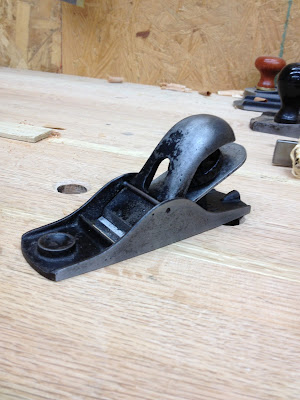I found myself getting very frustrated with the my bench. I couldn't find a decent way to hold the work while I planed. I needed a tail vise, plain and simple. As with most of my purchases, this started with what some might call a business plan. I have to come up with a well reasoned argument for why I need this tool, how often I will use it. This will include demonstrations and sometimes....begging. My wife has to be this way because if she didn't I would be living in a cardboard box huddled around my tools. Luckily, my wife was able to free up the funds for me to buy a Jorgensen 7" vise and some Veritas round bench dogs.
When the vise arrived I quickly got started on installing it. Installation was pretty straight forward. Just had to mortise out a place on the end of my workbench for the vise. I fired up the router and made pretty short work of it. A couple bolts later and I had the vise pretty much installed.
 |
| Installed Jorgensen 7" vise |
 |
| I added a chop and glued on some black leather and drafted a buddy to take a turn drilling dog holes. |
I discovered a bit of an issue. The quick release mechanism was not working consistently. When you would turn the screw in to tighten it would just freely spin. If I would just reach under the vise and barely touch the nut it would start to engage. I ask my brothers on Woodnet Forums and no one really had a solution. I continued to play with it and see if I could wrap my head around it. If you are not familiar with these vises here is what the nut looks like.
If you see on the sides of the nut there are little bosses. The limit how much the nut will spin free spin before it starts to engage or disengage the threads. I suspected that one of the bosses was letting the nut turn just a little too far. My first thought was to weld a spot on the boss. Since I don't know too much about welding I decided to try something else. What I decided to do was glue a piece of leather onto the boss that was giving me issues.
 |
| You can just see the little piece of black leather I added to the boss. |
As for the vise...I love it (after it was fixed at least). I honestly don't know why I didn't do this earlier. The vise doesn't have any sag and seems to resists racking well. I actually like the bench I built twice as much as the Lie-Nielsen benches that we used at Marc Adams. I love the flexability of round dogs. It gives me the option to use the dog holes for my dogs or my hold fasts. My bench is also heavier and doesn't try to "walk" away on me.
I added a row of dog holes down my bench (5" from front of bench, 3" on center). This seems to work out great. I would advise anyone to not skimp on the dog holes. I also chose to add a dog hole in my chop instead of using the dog that come with the vise. I wasn't a big fan of the built in dog. It wasn't quite tall enough for my installation and it looked like it might bend backwards and allow the wood to creep up it. Adding the dog hole in the chop was simple and has worked great.
Adding this vise was like a archaeologist finding the rosetta stone. My hand planes started to make sense to me. Planing boards flat didn't seem like such a task. I couldn't actually devote my time and brain power to the task at hand instead how to secure the work to the bench. It seems every so often in my woodworking life I cross a threshold where things just seem to instantly become clearer. These ah ha moments are what keep me interested in this craft.




